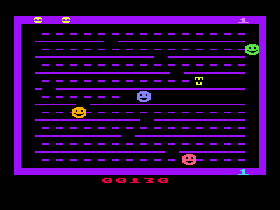 The Game: Ever had a sweet tooth? Now you are the sweet tooth – or teeth, as the case may be. You guide a set of clattering teeth around a mazelike screen of horizontal rows; an opening in each row travels down the wall separating it from the next row. Your job is to eat the tasty treats lining each row until you’ve cleared the screen. Naturally, it’s not just going to be that easy. There are nasty hard candies out to stop you, and they’ll silence those teeth of yours if they catch you – and that just bites. Periodically, a treat appears in the middle of the screen allowing you to turn the tables on them for a brief interval. (Tigervision, 1982)
The Game: Ever had a sweet tooth? Now you are the sweet tooth – or teeth, as the case may be. You guide a set of clattering teeth around a mazelike screen of horizontal rows; an opening in each row travels down the wall separating it from the next row. Your job is to eat the tasty treats lining each row until you’ve cleared the screen. Naturally, it’s not just going to be that easy. There are nasty hard candies out to stop you, and they’ll silence those teeth of yours if they catch you – and that just bites. Periodically, a treat appears in the middle of the screen allowing you to turn the tables on them for a brief interval. (Tigervision, 1982)
Memories: When Atari’s licensed version of Pac-Man hit the store shelves in 1982, it gained an instant notoriety as those looking for the perfect home Pac experience muttered a collective “screw this” and went elsewhere in search of a better game. Tigervision, a subsidiary of Tiger Toys making its first tentative steps into the increasingly-crowded video game arena, gave them that game.  Jawbreaker wildly changes the look and feel of the game, doing away with the maze structure and changing both protagonist and enemies, but then again, it’s not trying to be Pac-Man. Trying to emulate it to some degree, sure – but in trying to distance it far enough from the concept of Pac-Man to avoid legal trouble (home
Jawbreaker wildly changes the look and feel of the game, doing away with the maze structure and changing both protagonist and enemies, but then again, it’s not trying to be Pac-Man. Trying to emulate it to some degree, sure – but in trying to distance it far enough from the concept of Pac-Man to avoid legal trouble (home  computer gamers from around this time will recognize that 2600 Jawbreaker is actually based on Jawbreaker II), programmer John Harris paradoxically brought Jawbreaker closer to the fun factor of the original game than Atari did.
computer gamers from around this time will recognize that 2600 Jawbreaker is actually based on Jawbreaker II), programmer John Harris paradoxically brought Jawbreaker closer to the fun factor of the original game than Atari did.
